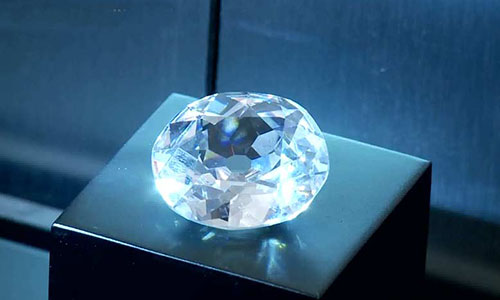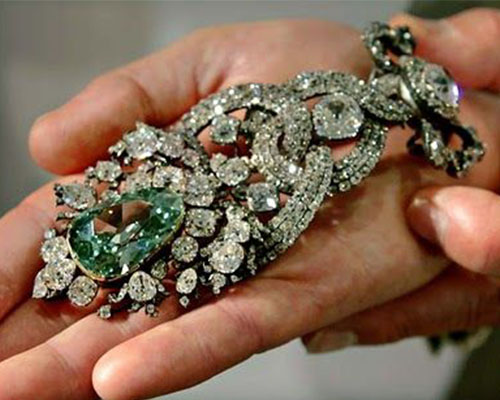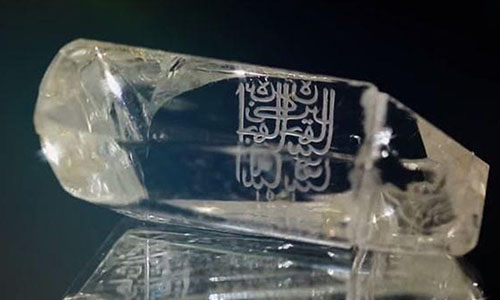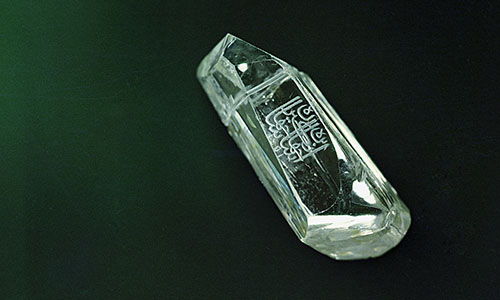The Golconda Diamonds are Indian diamonds mined in states of southern India. Golconda market was the primary source of the finest and largest diamonds in the world. Thus, the legendary name ‘Golconda Diamond’ became synonymous with Golconda itself. Universally esteemed as the world’s finest diamonds.

The Golconda region has produced some of the world’s most famous diamonds, specific geographic area in the present-day Telangana and Andhra Pradesh states of South India.
Golconda diamonds have a special whiteness often described as soft, watery, and pure so that light appears to pass through the stone completely unimpeded.
THE KOH-I-NOOR
“If a strong man were to throw four stones, one north, one south, one east, one west, and a fifth stone up into the air, and if the space between them were to be filled with gold, all would not equal the value of the Koh-i-Noor.”

The Koh-i-Noor “Mountain of Light” is one of the largest cut diamonds in the world, weighing 105.6 carats (21.12 g).

It has belonged to various Hindu, Mughal, Turkic, Afghan, and Sikh rulers, who have continued to fight bitterly over it at various points in history.
Koh-i-Noor Diamonds has undoubtedly changed hands between various factions in south and west Asia, until being ceded to Queen Victoria after the British annexation of Punjab in 1849.

Throughout the history of the stone, its owner’s history has been filled with violence, murders, mutilations, torture, and treachery. The curse of the Kohinoor Diamond is undeniable and is enough to make people cautious.
The British Royal family, have taken precautions after coming into its possession, with Queen Victoria stating only the wife of the male heir to the British throne may wear it.
Today, the diamond is on public display in the Jewel House at the Tower of London, where it is seen by millions of visitors each year.
Despite claims of ownership by four countries — India, Pakistan, Afghanistan, and Britain — the United Kingdom has maintained ownership over the gem
Historically, it is difficult to pass judgement on the legitimacy
DRESDEN GREEN

Dresden Green diamond, a 41cts Natural Fancy Green diamond a rare Type IIa, with a clarity of VS1, potentially internally flawless if slightly recut,
The Diamond originated from the Kollur mine in Golconda, India, named after the capital of Saxony in Germany, where it has been displayed in the New Green Vault at Dresden Castle for the last two centuries.

Its story begins in 1722 when the important diamond merchant Mr Marcus Moses brought the apple green diamond, probably in the rough, with him from India and showed it to His Majesty King George I of the United Kingdom.
King George I, didn’t buy the green beauty, instead, it was picked up by His Majesty King Frederick Augustus II from the Dutch merchant Delles at the Leipzig Fair in 1741. A year later, King Frederick ordered the court jeweller Dinglinger to set the diamond in the Decoration of the Golden Fleece but by 1746 this configuration was broken up to accommodate a new design by the goldsmith Pallard of Vienna of the Order along with the Dresden White diamond. Twelve years later Pallard’s Fleece was dismantled but the section holding the Dresden Green stayed intact as a hat ornament, as it can be seen today at the Green Vault in Dresden.

In 1988, GIA was allowed to grade the diamond and they determined the approximate carat-weight without taking it out of the historic metalwork and described it as modified pear-shaped brilliant cut in the Old European cutting style. It was, furthermore, stated that the colour was natural since its history predates the nuclear industry by almost two centuries and that is why the Dresden Green is today used as a basis for colour grading Fancy Green diamonds.
THE ARCHDUKE JOSEPH

The Archduke Joseph originated in India’s Golconda mines, a colourless, antique cushion-shaped brilliant, originally weighing 78.54 carats, it is the largest D, IF ever graded at the GIA, a Type IIa as determined by the Gübelin Gem Lab of Lucerne, Switzerland.

This magnificent stone was named after Archduke Joseph August of Austria, its first recorded owner.
In 1936 it was sold to an anonymous buyer who is believed to have been a European banker and kept in France. It surfaced at auction, but not sold, in 1961 in London and again at Christie’s in Geneva on November 1993.
On November 13, 2012, The Archduke Joseph (76.02 carats) was sold for more than 20m Swiss frank at Christie’s auction to an anonymous bidder. The price fetched was a world record for a Golconda diamond and a world record price per carat for a colourless diamond.
THE SHAH DIAMOND

The Shah is an 88.70-carat, bar-shaped, It was probably found in Golconda, partially polished diamond-bearing three engraved Persian inscriptions.
- The first engraving reads “Bourhan-Nizam-Shah-II, 1000”
- The next one reads, “Son of Jehangir Shah-Jehan Shah, 1051.”
- The third one reads “Kadjar Fath Ali Shah”

Source: TheDiamondTalk
In 1829, the Shah was given to Czar Nicholas I of Russia by the Persian Government in appeasement for the assassination of the Russian Ambassador, thus, becoming Crown Jewels of that country.
In 1914, when World War I broke out, the diamond was sent to St. Petersburg to Moscow for safekeeping. After the Revolution, when the strongboxes were opened in 1922 by the new regime, the Shah was among the treasures. It is now one of the prized possessions in the Russian Treasury of Diamonds & Precious Stones in the Kremlin.
It is displayed in the Diamond Fund of Russia in Moscow.
THE HOPE DIAMOND

The Hope Diamond is one of the most famous jewels in the world, also known as Le Bijou du Roi “The King’s Jewel” with ownership records dating back almost four centuries. The jewel is believed to have originated in India, Kollur mine, weighing 45.52 cts, a Fancy Dark Grayish Blue colour, Antique cushion cut.
The Diamond acquiring its “Hope” name when it appeared in the catalogue of a gem collection owned by a London banking family called Hope in 1839.

After going through numerous owners, it was sold to Washington socialite Evalyn Walsh McLean, who was often seen wearing it, along the “Star of the East” a 94.80-carat, pear-shaped, D-color stone of unknown clarity grade, likely originated from India.
It was purchased in 1949 by New York gem merchant Harry Winston, who toured it for a number of years before giving it to the National Museum of Natural History in 1958, where it has since remained on permanent exhibition.

On November 18, 2010, the Hope Diamond was unveiled and displayed at the Smithsonian in a temporary newly designed necklace called “Embracing Hope”, created by the Harry Winston firm, celebrating a half-century at the National Museum of Natural History.
A curse befell the large, blue diamond when it was plucked (i.e. stolen) from an idol in India — a curse that foretold bad luck and death not only for the owner of the diamond but for all who touched it
THE ORLOV DIAMOND

The Orlov is a large diamond of Indian origin, Kollur Mine, weighing 189.62 carats, currently displayed as a part of the collection of the Diamond Fund of the Moscow Kremlin. It is described as having the shape and proportions of half a chicken’s egg. In 1774, it was encrusted into the Imperial Sceptre of Russian Empress Catherine the Great.

This enormous stone is reputed to have been used as one of the eyes of a statue of the god Brahma in Mysore, from where it was stolen by a French deserter who pretended to be a convert to the Hindu faith. He escaped with it, and is later supposed to have sold it on the Amsterdam diamond market. The disgraced Prince Grigory Orlov, casting around for a way back into the favours of his former mistress, Catherine the Great, bought the great jewel and presented it to her.
The Empress accepted his gift and had it mounted on the imperial sceptre, but never allowed Orlov back into either her good graces or her bed.
It was indeed considered a point of PRIDE by any ruler to be the owner of one of the Golconda Diamonds!
On my closing note!
Shine bright like DIAMONDS!!

Thank you, nice post! This was the thing I needed.
Thank yoou!
Dano ci zycie, ktore jest tylko opowiescia. Ale to juz twoja sprawa, jak ty ja opowiesz i czy umrzesz pelen dni. – Marek Hlasko
Przyjazń to milczaca nieformalna umowa miedzy dwiema osobami odznaczajacymi sie instynktem spolecznym i zaletami serca. F. Arouet Czy wiesz jaki jest Socjologiczny aspekt tej sentencji ?
I discovered your blog site on google and check a few of your early posts. Continue to keep up the very good operate. I just additional up your RSS feed to my MSN News Reader. Seeking forward to reading more from you later on!
:))
I was researching the internet for some information since yesterday night and I finally found this! This is a impressive webpage by the way, except it appears a little hard to see in my verison phone.
Thank you!
Good post. Ive just forwarded the link to my coworker|.
Thank you!
I constantly spent my half an hour to read this web site’s
articles or reviews every day along with a mug of coffee.
Thank you,Ramona.
Great to become visiting your weblog once more, it has been months for me. Nicely this write-up that ive been waited for so lengthy. I want this write-up to complete my assignment within the college, and it has exact same subject with your write-up. Thanks, great share.
Thank you! Hope it was helpful in your project!
This is a appealing post by the way. I am going to go ahead and save this article for my brother to check out later on tonight. Keep up the good work.